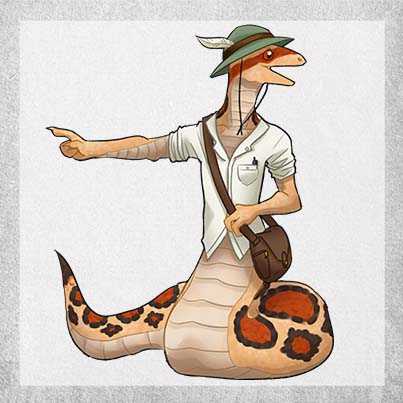
First and foremost, this game is all about having fun. Feel free to change, adapt and alter rules if you feel it would make things more fun for you and your group. Second, this game is a group game meant to be played with around 3-5 players and one person known as the Designer. The Designer's job, like in any good TTRPG, is to build a world and create a plot that the whole group can interact with. Together as a group, you will build stories and memories that can last a lifetime.
As the players interact with the world of Animalia, they will run into problems and obstacles that may require skill to overcome. When situations like this arise, a player's skills will be tested to see if it is possible for them to do the task at hand. If they aren't skilled enough, then it is possible they will fail the task they have set out to do.
There are three main skills in this system: the Arm skill, the Leg skill, and the Head skill.

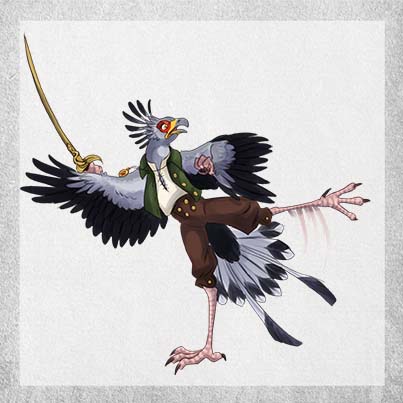

The Arm skill relates to the amount of skill a player has when they use their arms, hands, or any part of their body between the hips and the neck. This skill is used for things such as wielding a sword, punching someone, stealing something, or playing the guitar.
The Leg skill relates to the amount of skill a player has when it comes to using their legs. Tails, feet, and other body parts below a player’s torso are also considered to be related to the Leg skill. Actions a player could take that involve using this skill could be running, jumping, kicking, carrying heavy things, avoiding attacks, or balancing.
When it comes to the Head skill, this skill is used for any task that requires a player to use things associated with one's head. That could be using the brain, eyes, ears, nose, or anything above a character’s shoulders. Tasks that would require a player to make a Head skill check would be spotting a hidden treasure, convincing someone of something, biting, screaming, or recalling information read in a book.

Each of the three skills, Arm, Leg, and Head, have a number associated with them that reflects how skilled a character is at using them. This number is somewhere between 1-8 with a 1 meaning a character has no skill with using them, 2 meaning they have an average skill level, and 8 meaning they are an expert in that particular skill.
When a character approaches a situation where they need to use a skill, then the Designer will set a ‘Difficulty Threshold’ (or DT) for that action. The DT is a number that reflects how hard a task is or how much skill a character must have to accomplish the task. Once the DT is set, a player will then roll 1D20 and add the appropriate skill number for the task, and if the total of the roll plus the number they have in that skill is equal to or higher than the DT, then they succeed and have enough skill to do the task! If they get lower than the DT, they fail to do the task.
For example: if a player had a 3 in their Leg skill and they wished to kick down a wood door, the Designer may ask them to make a Leg skill check. The Designer would then set a DT determined by how difficult it may be to kick down the door, let's say they set it to 14 in this case. The player would then roll 1D20 and add their Leg skill (3 in this case) to see if they can kick down the door. If they get a 14 or higher they succeed in kicking down the door, if they get a number lower than 14 then they did not have enough skill to kick down the door and failed to do so.
Note: if a player gets much lower on their skill check than the DT, the Designer may inflict some kind of negative effect beyond just failing to do the action. For example, in the situation above, if the player got a 2 on their skill check (assuming they had a 1 in their leg skill) then they may break their leg when attempting to kick down the door. The same can also be applied to getting much higher than the DT. In these cases the player may have overkilled the task they were attempting to do. If this were to happen in the example above (say the player gets a 23) then the Designer can ask the player if they want to go overkill for the task. If the player agrees then it may cause the door to be thrown off the hinges and slam into anyone within the room. Both player and Designer must agree to an overkill action, but what happens in case of a failure of a skill check is always decided by the Designer.

Sometimes a task may require a player to use more than one type of skill. When this happens the average of both skills (rounded down) is taken to get the skill bonus that will be added to their D20 roll. For example: If a character was attempting to free climb a cliff, they would be using both their arms and legs to do so. So if they had a 1 in their Arm skill and a 2 in their Leg skill, they would have an average of 1 for skill in that task. They would then add the 1 to their D20 roll (1D20+1) when making the skill check.
Note for the Designer: When setting the DT you should take into account what kind of factors would make the skill harder or easier to accomplish. If a player is trying to bust open a door then you have to ask yourself, is the door made of wood, steel or something else? Often a 13 is considered to be an average DT. The lower you make it, the easier the task becomes. The higher you make it, the harder it becomes, with 28 being the max most players can get for a skill check. Also, if the player is attempting to make a skill check against another character, do not forget to add that character's respective skill when setting the DT. For example, if a player was attempting to convince an NPC (non-playable character) to do something, you may look at the NPC’s Head skill and then add it to a 1D20 roll to set the DT for the player’s skill check against them.

As a player goes on adventures and takes down foes they may be rewarded by the Designer with an increase in their skill level. This increase could be a whole skill point or a partial point as designated by the Designer. The points are handed out for accomplishing tasks such as defeating a big bad guy or finishing a side quest. The skill points can go into any skill that the player chooses and does not need to be delegated to a skill as soon as it is received.

Talents are specific actions a character is good at. Talents can do things such as improving a character’s damage in combat, increasing foot speed, being good at convincing others or aiding an ally in an attack. As a player goes on their adventure, their character will be able to increase their skill level. Whenever their skill level increases they have the opportunity to take a new talent related to that skill. For example: If a character gained one Leg skill point they could take a new Leg talent from a Leg talent pool equal to or lower than their new Leg skill level.
When a player's skill level is increased, they may choose to change one talent upon gaining a new skill point instead of gaining a new talent. The changed talent must be replaced with a talent in a talent pool that they have access to. For example, if they had just earned their fourth skill point in their Arm skill, they could change an old Arm talent for any talent from the 4th level Arm pool or lower. Doing this would replace the action of gaining a new talent.


Occasionally a dice roll may be rolled with advantage or disadvantage. When this occurs it means something is causing a character to have more luck or less luck when taking that action and this luck should be applied to the dice roll. You can not stack advantage or disadvantage on dice rolls. This means that if a character has two factors that would give them advantage (or disadvantage) they still only apply advantage once and do not stack it. If a character has both advantage and disadvantage on an action, then the two negate each other giving them no extra bonus. When a player rolls a die with advantage or disadvantage the following happens:
Advantage:
If it is stated that a player rolls something with ‘advantage’, then they roll two of the designated dice and use whichever number is higher.
Disadvantage:
If it is stated that a player rolls something with ‘disadvantage’, then they roll two of the designated dice and use the lower number rolled.

AOE’s are effects like attacks or abilities that affect a large area of things rather than just a single target. Things such as a raging fire or a harsh, loud sound have an area of effect. When an AOE is in play, all creatures within its area must make a skill check with a DT set by the AOE to negate or minimize its effects. (This could be a Head skill check if it was a sound wave or a Leg skill check if it was a fire). Any creature who fails the skill check takes the full effects from the AOE. If they succeed the check, they manage to dodge the worst of it and only take half damage and avoid any secondary effects unless specified otherwise.

After a long day, everybody needs to take some time to reset and regain their energy. When a character sleeps for more than 6 hours, they take what is called a ‘full rest’. During a full rest, all base HP is regained. There are also some talents and weapons that have abilities that can only be used once and reset after a full rest has been completed. (See talents and weapons for specific info). Some talents can only be used right before a full rest during what is referred to as ‘down time’. These actions happen right before you drift off to sleep and can be done at the same time as keeping watch.

There are creatures, foes and dangerous situations that characters may find themselves in as they go on adventures and they may need to fight to get themselves out of these tight spots. Combat in the Animalia TTRPG is geared towards working as a team to defeat foes so table talk is highly suggested. However when deciding what actions to take, the Designer and other players should make sure that everyone gets a say and no one person is calling all the shots.

When a fight starts all characters are split into two or more groups. The way the groups split is determined by who is fighting with who. The most common split is allies versus foes with each group sharing a turn. However, there can be more turns added to the round if there are more than two groups fighting. In combat a turn is the amount of time it takes for all the creatures in a group to finish their actions and a round is the amount of time it takes for all turns to be completed.
For example, if the groups were split into allies vs foes, then there are two turns: the allies’ turn and the foes’ turn. It does not matter what order the actions of each character takes as long as it is taken within their turn. Any creature can take actions during their turn as long as they have the action points to do so (see action points below for more info) and it does not interrupt the actions of another creature.There is NO set order that characters take actions within a turn.
For example, a turn could play out as follows: player 1 runs forward 20 feet, player 2 then attacks a nearby foe, player 1 attacks a foe, player 2 then runs over to player 1 and heals them. This is a valid turn.
Once all groups have taken their turn and all actions have been resolved, then that is the end of the round. At the start of a group’s turn all action points are reset. (see action points for more info).
The group that goes first when combat is started is based on what character initiated the fight and took the first combat action, that character's group goes first in the round. If it is unclear who started the fight, each group will roll 1D20. Whichever group has the highest roll goes first. If there is a tie, the dice are rolled again for the groups that are tied to determine who of the tying groups goes before the other. Again, the highest roll goes first.
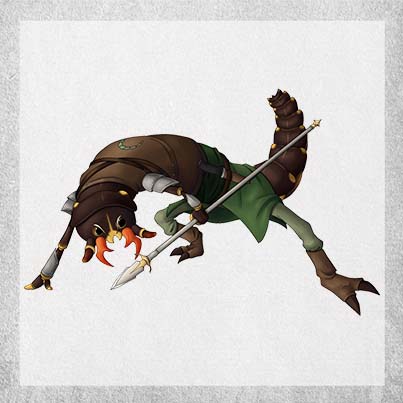
Every character has what is known as AP (or action points). These are used for combat to determine how much energy each character has to complete tasks. Each character starts out with 4 action points per round. Action points refresh at the start of the user’s turn, so if a player does not use all their action points by the start of their next turn, they will be wasted. Different actions take different amounts of AP to use. Below is a list of the most common actions a character can use, but there are other kinds of actions as well.
- Movement action | 1 action point
- Attack action | 2 action points
- Small action | 1 action point
- Group action| Varies on action
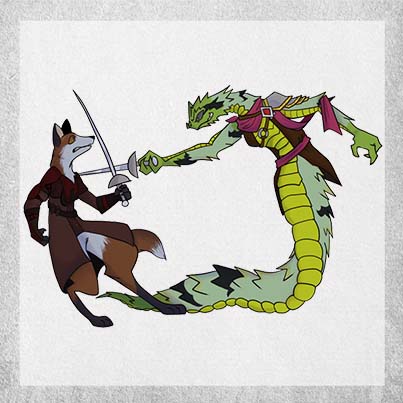
If you do not use all your action points during your turn you can use them during your opponent's turn as reactions. A reaction can not interrupt any type of action from taking place (unless stated otherwise). For example, if an opponent uses 2 action points to use an attack action, the attack action must be completed before a reaction can be used against the opponent. Below is a list of common reactions.
- Retaliate | Varies on action
- Opportunity attack | 1 action point
A character can use multiple of the same action in a round if they have the AP for it. However if they use the same action twice, then during the next round that action will cost them twice as much AP to use. The extra cost for the action changes back to its normal amount after one turn.
For example, if a player used two attack actions (normally costing 2 AP each) in one round, then the next round it will cost them 4 AP to use one attack action. If they use only one attack action on the second round, then on the third round their attack action will cost 2 AP once more.
An attack action is the most common action taken during combat. It costs 2 AP to use unless stated otherwise. When a character attacks a foe they must make a skill check against the foe’s defense to determine if the attack hits them or not. This skill check is called a ‘hit’ check. The character attacking rolls 1D20 and adds the appropriate skill depending on the attacking weapon and type.
For example: if a creature were attacking with a sword by slashing with it, they would add their Arm skill to the D20 roll. (See weapons for what skills are used for what types of attacks.)

If the attacker gets a number equal to or higher than their target's defense stat (Defense is calculated by using their armor + their Leg skill. See armor for more info on defense.) then the attack hits and the attacker rolls for damage. This roll is known as a damage roll. The damage dealt depends on the weapon. The damage is the base damage of the attack + the skill level needed to make the attack. (See the weapons section below for more info.)
When attacking an enemy from afar a character makes what's known as a ‘ranged attack’. To use this kind of attack, a character must have a line of sight between them and their target (i.e. they can not have an object or another character between them and their target). If another character is near the path of the ranged attack and the hit check is failed by a large margin then the Designer may cause the attack to not only miss its mark but to also go astray and hit the nearby character as well. Also, if a ranged attack is made against a character within 5 feet the ‘to hit’ roll is done with disadvantage as they are too close for a character to aim well.

Every instance of damage has a type of damage that it deals. Certain creatures or armor may have a weakness or resistance to certain types of damage.
If a creature is resistant to an attack, that attack deals one damage die less of damage. For example if a creature is resistant to a damage type, if they are hit with an attack that deals that damage type, then an attack that normally deals 1D6 damage now deals 1D4 instead, or if the attack would deal 1D4 damage it now deals 1D2 damage. An attack can not deal less than 1D2 of damage.
If a creature is weak to a damage type, that damage type deals one damage die more of damage, so if it would deal 1D6 damage normally it now deals 1D8. If an attack deals 1D20 or more of damage then their weakness is not applied to that attack.
The following are damage types that exist in this system; bludgeoning, slashing, piercing, poison, hot, cold and sound.
When attacking foes, it is often best to do so as a team rather than one on one. By attacking a target with allies, players can give each other a boost to their attack, defense, and more. Some common group actions everyone can use are listed below.
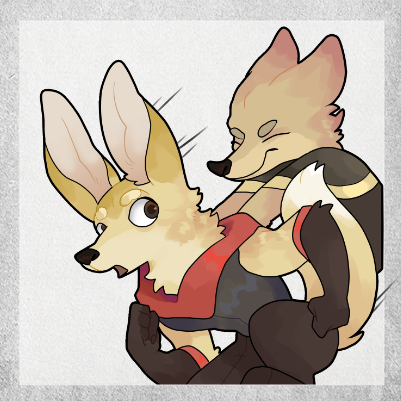
Reposition:
When a character uses the reposition action, they use two action points to cause an ally within 5 feet to move in a straight line a distance up to the character's base movement speed. The ally they reposition can not end their turn in an occupied space and can not move through other characters or large objects and will stop 5 feet in front of objects or characters that would cause them to stop their movement.
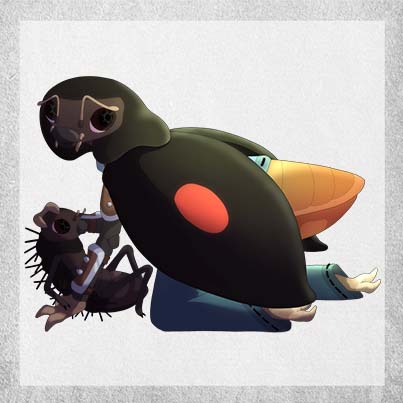
Defend Your Friend:
A character strengthens their pose and gets ready to defend their allies. Using one action point, a character can cause any allies within 5 feet of them that have already dealt damage to the target this round to gain extra defense equal to half the defending character's Leg skill rounded up. This buff remains active until the start of the defending group's next turn. The buff is instantly removed if the defending character or the ally they are defending moves out of the 5 foot range or the defending character uses an attack action or reaction.

Double Hit:
If an ally has dealt damage to a target this round a character may use one action point to gain advantage (see advantage) on their ‘hit’ roll against that same target. On a hit they also deal an additional 3 points of damage.
A character can use 1 AP to use a small action. A small action is a quick, simple thing that doesn’t take much energy to do. Some weapons or attacks may take a small action rather than a main action to use. Switching out a weapon to a new weapon is another example of a small action.
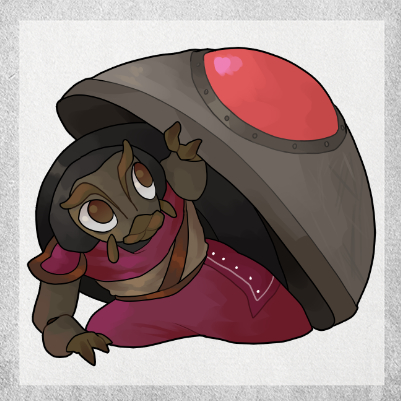
Defend Action:
The defend action is a small action costing 1 action point. When a character uses the defend action it causes their defense to increase by half their Leg skill (rounded up). This buff resets at the start of the character's next turn.
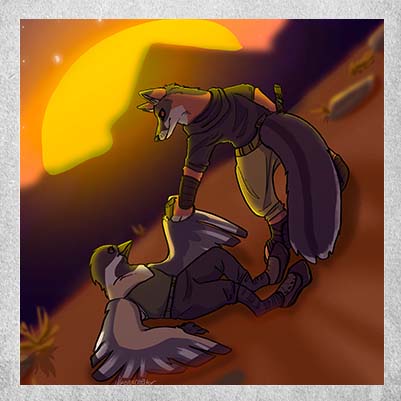
Help Action:
Sometimes a character's allies need a bit of help with a task. If an ally within range would benefit from a character helping them then they may use one action point to do so. When they do this, the ally can add their skill to the skill check they are trying to make.
For example; if an ally was hanging on a ledge, a character could use one action point to help pull them up. The ally would then be able to add the character's arm skill to their roll to get up. You can not use a help action more than once per round.
Reactions can only be used when it is not a character's turn and only after the completion of another creature's action unless stated otherwise.

Retaliate Reaction:
The retaliate reaction uses AP equal to the attack action being used and can only be used after taking damage from another creature within range. When a foe causes a character to take damage, the character can use the retaliate reaction to use an attack action against the foe. If the character hits the foe with a retaliate reaction they take half the damage of the normal attack action. It still takes the normal amount of points the attack action would consume to use.

Opportunity Attack Reaction:
When a foe attempts to move out of the area that is within 5 feet of a character, they may use 1 action point to make an opportunity attack reaction against the foe. An opportunity attack reaction can be any attack action that normally costs 1-2 action points and has a range of 5 feet.

When wielding a weapon, there often are multiple ways in which a character can use it from stabbing to slamming. The different ways a character wields a weapon will determine what type of damage it deals, however the amount of damage a weapon deals will always remain constant. The different kinds of attacks a character can use with a weapon may require different levels of skill to use depending on how difficult the attack is to pull off.
For example; thrusting with a rapier requires a Leg skill of at least 5 or higher to use, whereas a slash with a rapier requires an Arm skill of 4.

When attacking, the skill level required to make a weapon attack is added to the attack's damage roll. If a talent or other situation would allow a character to use a weapon without needing the skill level to do so, the character uses their current skill level if it is lower than the skill level needed to wield the weapon. If it is higher than the skill level needed to use the weapon, then the attack's skill level is used for the extra damage like normal.
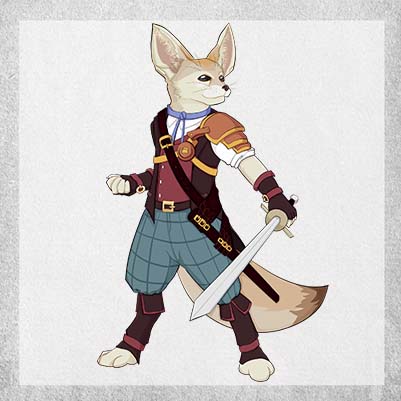
Depending on the size and weight of a weapon or item it may use one or two hands to wield it. One handed weapons tend to be weaker when it comes to damage, but they allow for a character to have one open hand for a second weapon or item giving them greater flexibility.
Some weapons can be thrown at a target much farther away than the standard melee attack (5 feet). However, it must be retrieved from the place it lands if it is to be used again. It also follows all the same rules as ranged weapons when it is being thrown.
A few weapons also have a diameter range with their effect, like smoke bombs or caltrops. These effects work similarly to an Aoe. The range for these weapons is the edge of the AOE effect. For example. If a player had a weapon that had a range of 10 feet with a diameter effect of 20 feet the player could choose to have the edge of the effect start 10 feet away from them.
You can look here for a list of all the weapons and their stats.

Armor is what protects characters from taking damage. Different kinds of armor give different kinds of protection with some giving resistances to common forms of damage.

To use different types of armor a level of skill with your legs is required to keep yourself upright while you move around with the extra weight.
When calculating a character's defense they add their normal base defense (7) plus the skill level needed to use any kind of armor they have on.
If a character has a talent that allows them to use any armor without needing the skill level to do so, they add their current Leg skill level to their defense if it is less than the amount needed to use the armor. If it is more than the amount needed to use the armor, they use the armor's skill level instead.
Alongside standard armor, shields can also be used to buff a character's defense. The buff from shields is added on top of their normal defense as long as they are wielding the shield. To wield a shield an arm or two is required. A character can not hold something in the hand wielding the shield.
You can look here for a list of all the armor types and their stats.
When a character is hiding behind objects such as a stone wall or a bush they make it harder for enemies to hit them. This is reflected in the ‘hit’ roll.
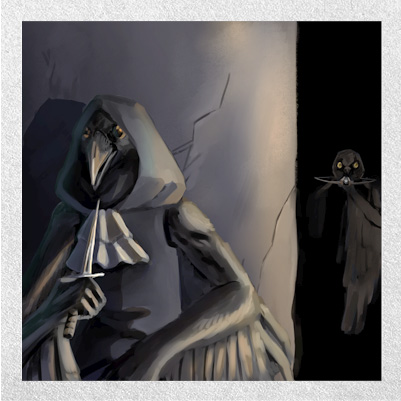
Full Cover
Full cover is when a character is almost covered entirely. This could be because they are crouched behind a fence or are sitting around a nearby corner. When a character attempts to hit a target with full cover, a Head skill check with a DT of 16 must be made. If it is successful then they may make their ‘hit’ roll with disadvantage. If they are not successful, their attack acts as if they failed their ‘hit’ roll.

Partial Cover
Partial cover is when a character is about halfway hidden behind something. This could be if they are standing behind a fence or are in some thinned out trees. When attempting to hit a creature with partial cover, the ‘hit’ roll is done with disadvantage.
Sometimes when a character is out adventuring, the weather, ground and area around them can become extreme. When traveling through these areas for long stretches of time they may find themselves in less than peak condition.
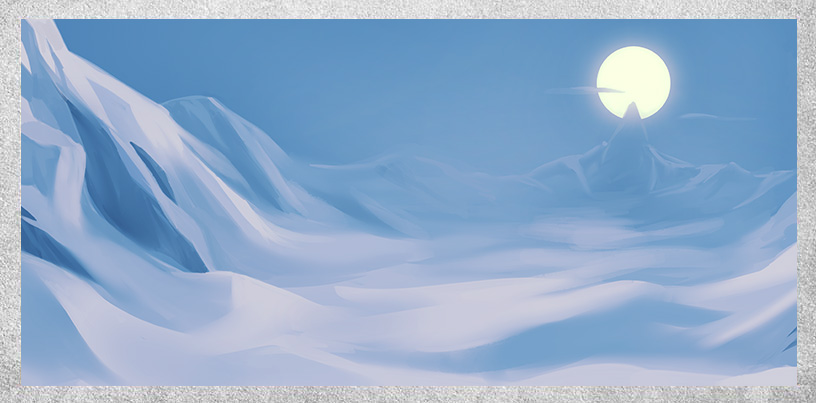
Extreme Terrain
When in extreme terrain a character gains a -2 to all ‘hit’ rolls.
A character loses 1 action point every round for every three days (rounded up) they are within this terrain without proper gear or protection. (i.e. if they have been in extreme terrain for 6 days then they lose 2 action points every round)
If a character takes a full rest in extreme terrain without the proper gear they only recover half HP. So if they would have recovered 10 HP in normal conditions, they only gain 5.

Uneven Terrain
Uneven terrain is considered to be small patches of ground or brush that are uneven or hard to travel through normally. Trying to walk through these terrains, the following debuffs are applied.
A character’s movement speed is halved.
If there are any dangerous items in the terrain (such as thorns or sharp rocks) a Leg skill check with a DT of 16 must be made as soon as a character enters the terrain or if they start their turn within it. If failed, they take the appropriate damage or condition given to them by the dangerous items.
Sometimes a character may have to deal with physical ailments that give them negative effects. The variety of effects are known as conditions and remain in effect until cured. The way to cure an effect varies depending on the effect.

Bleeding Out
During an adventure a character may find that their HP (hit points) are getting dangerously low. When a character reaches 0 HP, their time is short as they start to ‘bleed out’. Every round after their allies’ turn ends but before their opponents’ turn begins, they must make a skill check using all their skills (Head, Leg and Arm averaged) with a DT of 8 + the number of rounds they have been bleeding out for.
The character has until they fail this saving throw to attempt to become stable either through a medical pack or any other means of gaining HP. If an ally is within 5 feet of them and uses a help action, they can cause the character to add one of their allies’ skills to the character's roll. The skill must relate to how they are aiding the character.
For example: if the ally is using their hands to stop the bleeding they would add their Arm skill.
If at least 2 allies within 5 feet use their help action to help the bleeding out character, the character can not die or fail the skill check. If more than 3 allies come to the character's aid, they become instantly stable.
If a character is stable, they are unconscious and no longer need to make any skill checks.
If a character takes any damage while they are making their skill check against dying, they instantly die. They also instantly die if they fail any of the skill checks. If they take any damage in their ‘stable’ state, they must start to make the skill check against dying again.
While they are bleeding out, their movement speed is halved, they can not use any attack actions and their action points are halved (rounded up).
Fallen
The fallen condition is something a character gains when they fall over. This can be from being pushed or even tripping. If a character has the fallen condition they gain disadvantage on all Arm skill checks and automatically fail all Leg skill checks. Any melee weapons they attempt to use that use the Arm skill also gain disadvantage on their ‘hit’ rolls. Their movement speed is also reduced to 5 feet. It takes 1 action point to get back up.
Intentionally falling is a free action and costs no AP to do. However it still costs the 1 action point to get back up if you have willingly fallen.

Frightened
When a creature is Frightened they can’t move any closer towards the source of their fear. They can escape the frightened condition by using one skill point to attempt a Head skill check. If they succeed then they no longer have the condition. They also no longer have the condition if they take any damage or if they can no longer see the source of their fear. If the cause of the frightened condition does not specify a DT for the skill check then the DT is 13.
Choking
A character can choke for many reasons, from drowning to eating something wrong, but what they all have in common is that they can be life threatening.
When a character has the choking condition they must make a Head skill check greater than 14 + the number of minutes they have been choking for. If they succeed in this skill check then they must make it again in another minute or at the end of the round if they are in combat. If they fail this check they instantly gain the passed out condition. If they are unable to remove what is causing them to choke, then they will die one minute after passing out. If at any time whatever is causing them to choke is removed (for example they surface for air above the water) then they instantly succeed the skill check and are freed from the choking condition. However if they gained the passed out condition from choking, the passed out condition is not removed.

Starving
Most Animalia can only go about 1 day without food before they start to get weak and if they go 3 days without food they will die.
If a character has not eaten any kind of meal within the last 24 hours then they gain -1 to all Arm and Leg skill checks made until they eat again.
If they have gone longer than 48 hours without food then they gain disadvantage on all Arm and Leg skill checks and gain -1 to all Head skill checks. Their defense also decreases by 5.
If they do not eat for 72 hours or longer then they are considered to be ‘bleeding out’ and must make a check against it at the end of every full rest (each extra day you go without food is considered to be a round for this check) and at the end of every round if combat is initiated. Allies can not use the help action if you are ‘bleeding out’ from starving. You also have all the negative effects of not eating for 48 hours.
Paralyzed
When paralyzed, a character’s move speed is halved (rounded down to the nearest multiple of 5) and their action points are reduced by 1 every round they are paralyzed (they can not have less than 1 action point due to being paralyzed).
They can escape the paralyzed condition by using one skill point to attempt a Head skill check (this check can be made once per round). If successful, the paralyzed condition is removed at the start of their next turn.
If a DT is not set already for this check then the DT is 14.
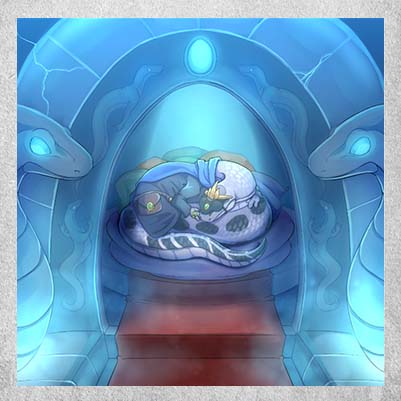
Passed Out
A character can have the passed out condition for many reasons, this could be because they fell asleep or someone punched them incredibly hard.
When they have the passed out condition, they can’t use any action points, they can not move on their own and they are unaware of what is going on around them, be it visually or auditorily.
If a character has this condition from falling asleep then they are instantly cured of it as soon as they take damage of any kind or a creature uses an action point to wake them up. The condition is also removed after a full rest.
If a character gained this condition due to alternative sources such as being punched or choking then the condition is removed by gaining HP (this could be from someone healing them or gaining HP after a full rest).
Unrested
Many things can cause a character to not get the full night’s sleep, and when this occurs, they won't be at their peak performance. This could be from sleeping on the cold, hard ground, because they drank too much the night before or had vivid nightmares all night long.
When a character has the unrested condition they gain half their full HP during their attempted rest. Their movement speed is also decreased by 10 feet until their next full rest. This speed decrease can not make a character’s speed lower than 5 feet.

Perked Up
Sometimes there are things that brighten an Animalian’s day, even if it's just for a short amount of time.
A character with the perked up condition gains +1 to any skill check using one skill of their choosing (chosen upon becoming ‘perked up’). This bonus does not apply to their defense, hit or damage rolls.
Satisfied
A good meal or other things can cause an Animalian to feel satisfied, making things feel a bit easier for a while.
Satisfied characters gain +1 to all skill checks they are forced by another character to make for the next 24 hours.
For example: if a foe was attempting to persuade a character with the satisfied condition and made a persuasion check against them, the satisfied creature would gain +1 to the DT the foe had to make against them. This bonus does not apply for the consumer's defense, hit or damage rolls.

Filled
Bursting with food can cause any Animalian to feel at peak condition.
‘Filled’ characters gain +10 foot speed, gain +1 on all their ‘hit’ rolls and +1 to their defense. Also, once per full rest, they can cause any die roll that is a 1 to be rerolled.
A character's base movement speed is set by their subspecies. This speed is how fast they can move over land across normal terrain. Other movements’ speeds can be found below.

Climbing
A character's base climbing speed is half their base Foot speed rounded down to the nearest multiple of 5 (with a minimum of 5 feet). Also, when climbing, a character must make an Arm and Leg skill check (taking the average of the two skills) before their movement to see if they continue to hold onto the surface they are climbing. The DT for this skill check is set by the Designer based on how difficult the climb is. If a character falls from 10 feet or less they do not take damage. However if they fall from higher than 10 feet, they take 1D4 of bludgeoning damage for every additional 10 feet above the base 10 feet they fall from.
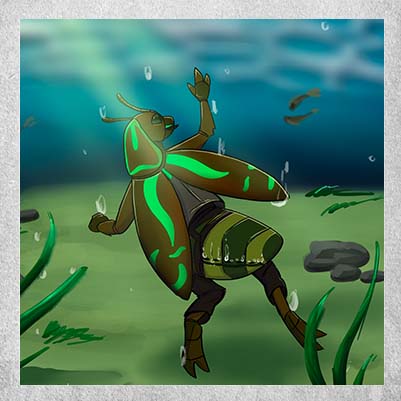
Swimming
A character's swimming speed is half their base movement speed rounded up to the nearest multiple of 5 (with a minimum of 5). If they stay on the surface of the water they do not need to make a skill check when they move in the water. However if they dive under the water they must make a check with a DT of 10 against choking if they have been submerged for 3 minutes or more. This check is made after every minute. If the skill check is failed they gain the choking condition.

Digging
In standard soil, a character can move a cubed foot amount of dirt equal to their Arm skill within an hour. With harder soils such as rocky ground, the time it takes is doubled.
For example if a character has a 3 in their Arm skill they could move 3 square feet of dirt in an hour.

Jumping
by default, characters can jump up a distance equal to 1/6th their height and a distance of half their foot speed.

Sometimes a character is granted temporary HP. Temporary HP stacks on top of a character's base HP and if the character takes damage it is taken first from the temporary HP until the temporary HP is fully used. Multiple sources of temporary HP can not be stacked. If they would gain a second source of temporary HP it replaces the old temporary HP.
For example, if a character had 5 points of temporary HP and then gained 10 points of temporary HP the 5 points would be replaced by 10 points giving them a total of 10 points of temporary HP. A player can always choose if they want to take temporary HP.
Some things grant a character an extra bonus to a roll when attempting to make a skill check or deal damage. These bonuses are called flat number bonuses and can not stack. However, a character can have both a flat number bonus and an advantage bonus on the same roll.
For example, if a player were granted +2 to their to-hit roll from a talent and then got a weapon that granted them +1 to its hit roll they would have +2 on their to-hit roll as the two bonuses do not stack. A player can always choose what flat bonus they want to use. However, if a sword granted them advantage on their to-hit roll instead, they would have both advantage and +2 on the to-hit roll.